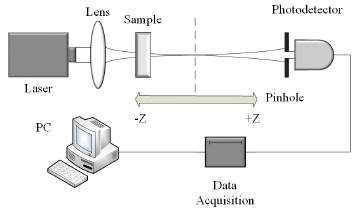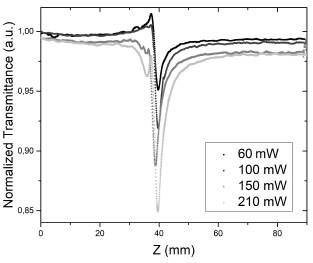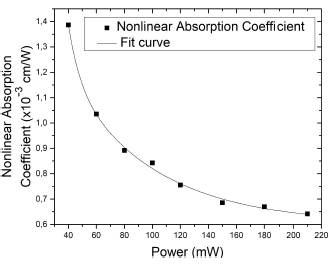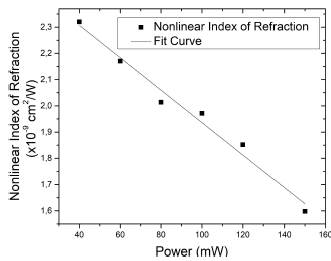1. Introduction
By way of the invention of the laser in the 1960s, a great variety of new optical phenomena were observed, such as the second and third harmonic generations, among others. Then, the study and theoretical description of these phenomena led to development of the non-linear optics (NLO) [1, 2]. In recent years, NLO has become an important area of research due to its multiple and potential applications in the fields of photo-electronics and photonics. NLO studies phenomena occurring due to the modification of the optical material properties by the presence of intense electromagnetic fields [3].
When these fields interact with matter, there are changes in their optical properties, such as variation in refractive index, changes in its polarization state, and changes in absorption coefficient, among others. There are a great variety of methods for measuring those non-linear effects, such as non-linear interferometry, 2-wave interferometry, 4-wave interferometry, elliptic rotation, spatial beam distortion and Z-scan [4]. However, some of these techniques require complex experimental setups and expensive equipments. For this reason, the Z-scan technique, developed by Sheik-Bahae et al., [5] has become a standard tool to determine non-linear parameters of materials due to its relative simplicity, sensitivity, and precision, besides other characteristics [6, 7].
Compounds of mineral origin have great potential for application in photonic research. For this reason, considering the 20W-50 reference multi-grade oil with mineral base for engines, a study was carried out of its NLO properties. Where ’W’ stands for winter and the number 20 indicates the degree of viscosity at low temperatures and the last number, 50, indicates the degree of high-temperature viscosity. The latter being an indication that the oil has higher performance at high temperatures, according to the Society of Automotive Engineers (SAE) [8]. This peculiarity is interesting, because exposing the sample to high intensity radiation will generate local heating on it. For this reason, the non-linear optical properties were studied as a function of the laser power. This study will allow determining the potential technological applications of NLO.
2. Methodology
2.1 Material studied
Multi-grade 20W-50 motor oil is a mineral oil, constituted by hydrocarbon oils derived from crude oil. To obtain it, first, it is necessary to carry out a vacuum fractional distillation, and then it is extracted with liquid propane; thus, obtaining crude lubricants. The oil obtained contains hydrocarbons with 20 to 30 carbon atoms, see Figure 1. Subsequently, it undergoes a dearomatization process that consists of extracting with furfural to eliminate aromatic hydrocarbons. The resulting product from the extraction is solid due to its high paraffin content and, therefore, is subjected to a second operation called dewaxing. The paraffin is removed by dissolving the oil with a mixture of toluene and 2-butanone, which is cooled to -5◦C until the paraffin is crystallized and is removed by filtration to, finally, obtain the lubricating oil [8].
2.2 Experimental set-up
To measure the NLO properties, 2 ml of 20W-50 lubricating oil was poured into a 1-mm thick glass cuvette and the Z-Scan technique was used by transmission in closed-cell configuration, as shown in the scheme in Figure 2. The pinhole in the diagram shown in Figure 2 is removed to obtain open-cell configuration. A continuous wave (CW) Nd:YAG laser, emitting at 532 nm and regulated in electric current was used and its laser beam was focused with a convergent lens, f= 40 mm focal length. The beam waist at the focus of the lens was measured using the knife method [9], obtaining a waist value of the beam of w0= 46.84 μm and a Rayleigh length of z0 = 1.30 cm. A pinhole of 0.01 mm of diameter (S = 0.023) and a 1 cm2 large area photodetector were used. For sample displacement, a stepper motor of 1.8° per step was incorporated into the linear displacement bank. For each step, the sample moved 0.04 mm. The study was performed as a function of the laser power, from 40 to 210 mW, performing a 90-mm scan along the z-axis.
2.3 UV-Vis characterization
The absorption spectrum of the sample was taken by using a UV-Vis EVOLUTION60S ThermoScientific Spectrophotometer, in a wavelength range of 200 to 1100 nm [Figure 3]. The maximum absorption peaks are observed in a range of wavelengths from 200 to 346 nm, which allows using a 532-nm laser in the Z-scan technique because of very low absorbance is evidenced at this wavelength.
3. Results and Analysis
To study the behavior of the non-linear absorption coefficient and the non-linear refractive index in the lubricating oil, the Z-scan technique and the theory developed by Sheik-Bahae et al., [5] were used. If the sample is exposed to high energy density, such as the energy density of a laser, the absorption coefficient and refraction index are no longer constant and depend on the intensity applied to the sample, as indicated by Eqs. (1) and (2) [5, 6, 10]:
Where I is the laser intensity, is the linear absorption coefficient and n 0 is the linear refractive index, which were determined for the lubricating oil using Lambert-Beer Law and Snell Law, obtaining values of 0.0351 mm-1 and 1.45, respectively. To obtain β, the open-cell Z-scan configuration was used. According to the theory by Sheik-Bahae et al., the transmittance can be expressed as a summation in terms of the initial intensity peak, as it is shown in Eq. (3)
where  Finding the máximum and minimum values of equation (3) and for m = 1, the non-linear absorption coefficient takes the form in Eq. (4) [5,11, 12],
Finding the máximum and minimum values of equation (3) and for m = 1, the non-linear absorption coefficient takes the form in Eq. (4) [5,11, 12],
Where ΔT
pv
is the peak-to-valley transmittance difference,  is the initial laser intensity (the average value on this study was 3409.449 W/cm2), and
is the initial laser intensity (the average value on this study was 3409.449 W/cm2), and  is the effective sample length
is the effective sample length 
The data for transmittance in the open-cell configuration as a function of laser power are shown in Figure 4, where we observed that when the sample is in the far-field region, the recorded transmittance corresponds to the value of the incident laser intensity. As the sample moves towards the focus, transmittance decreases, with a valley at the focus (z = 40 mm), indicating reverse saturable absorption effect [6, 10]. The behavior at low laser emission Powers induces a small increase in temperature (the small peak), that could be because of the composition of the lubricating oil, as it is made up of additives, and most of this additives for the 20W-50 respond at low temperature. On the other hand, when laser emission powers increases, the small peak disappears, and it can be observed just the valley at the focus of the lens.
We can observe that when the laser’s emission power increases, the peak-to-valley transmittance difference increases proportionally. Figure 5 shows a variation of the non-linear absorption coefficient as a function of the incident laser power, showing that this coefficient decays exponentially. Values of non-linear absorption coefficient as function of the laser power are shown in Table 1.
To determine n2, the experimental setup in Figure 2 was used. From the curves obtained in this configuration, ΔTpv is calculated and the variation of this quantity is given as a function of the self-phase modulation at the lens focus  Eq. (3) [5],
Eq. (3) [5],
Table 1 Values of β, n2, Re {x(3)}, Im {x(3)}, and x(3) as a function of laser power; with n0 = 1.45

Where S = 1 - exp is the transmittance fraction transmitted by the pinhole, hence, the non-linear refractive index is given by, Eq. (3) [11, 13]
is the transmittance fraction transmitted by the pinhole, hence, the non-linear refractive index is given by, Eq. (3) [11, 13]
Using the fact that the peak-valley position separation must remain constant, Δz
pv
= 1.7z
0 [5], and considering the fact that S <<1 (S = 0.023) and L << z0, then  which reduces Eq. (3) into Eq. (3)
which reduces Eq. (3) into Eq. (3)
Normalized transmittance curves were obtained depending on to the laser power, showing a máximum on transmittance (peak), followed by a minimum in the transmittance (valley), Figure 6. This behavior indicates that a self-defocusing of incident radiation occurred in the sample as it passed through the lens focus, which indicates that the non-linear refractive index sign for 20W-50 multi-grade lubricating automotive motor is negative. This effect is strongly associated to the local variation of the refractive index with temperature. An increasing transmittance is noted as the laser emission power increases [Figure 6].
However, it is observed that as the laser’s emission power increases, the non-linear refractive index decreases, but this trend can be observed up to a power value of 150 mW, see Figure 7, where values of the peak-valley position difference are maintained almost constant, but for the data at powers of 180 and 210 mW, this value increases a little compared to the previous ones. All the measurements show the peak-valley position difference of 2z 0 [5, 13] and this is a clear indication of termal nonlinear optical effects because of the sample was exposed to high-intensity radiation.
The third-order susceptibility, x(3), is determined by means of the following relation, Eq. (3)
Where Re{x(3)} and Im {x(3)} are the real and imaginary part of third-order susceptibility, respectively, and are given by Eqs. (3) and (??) [11,12]
and
The values of the non-linear absorption coefficient, non-linear refractive index, real and imaginary part of the electric susceptibility, and magnitude of the third-order electrical susceptibility are shown in Table 1. The magnitude for x(3) was found to be large and it is due to thermal effects since this is indirectly related to n 2 and β.
4. Conclusions
The NLO properties of 20W-50 multi-grade motor oil were determined for laser power values ranging from 40 to 210 mW. The non-linear absorption coefficient was obtained from the transmittance curves in open-cell configuration, finding that the non-linear absorption effect is associated to saturable absorption. The non-linear refractive index was obtained from the transmittance curves for the closed cell configuration, where a direct relation between laser power and difference transmittance was observed; however, the non-linear refractive index decreases as the laser emission power increases, but this behavior is only evident from 40 to 150 mW, where the peak-valley separation remains almost constant. Non-linearity is a result of thermal nonlinear optical effects in the sample as it undergoes local thermal heating due to the exposure to high-intensity radiation and long exposure time, generating an increment int the temperature of the medium and inducing a change in refractive index.
In addition, the magnitude of the third-order electric susceptibility was calculated for each power value; these results are shown in Table 1 and it is observed that the order of magnitude of this value is considerably large compared to other samples in the literature [6,11,12]. These results allow us to observe that a non-linear response occurs at low and high power, concluding that the multi-grade 20W 50 automobile lubricant oil offers high non-linear sensitivity.
































